Shelly Goodman Wright's Blog
August 26, 2019
The Wrights Take Italy
 Planning and General InformationFirst thing, we had to decide where we wanted to start in Italy and where we'd end. It really is important to figure out first since Italy is a large country. Getting a direct flight from Denver, Co. wasn't going to work out, however, we managed to have as few transfers as possible. Most flights stop in Frankfurt or Munich where you change planes to Italy.Luggage--We stayed in Italy for two weeks, so we brought a lot of luggage with us. This was something I wish I would have planned better. Sure, they have Taxi's, but getting a Taxi big enough for a family of five with luggage is difficult. As told by a Taxi driver, the Taxi van vehicles are limited and double the price. We made the mistake of taking two taxis to the main train station where the taxis dropped us off at two different locations, leaving me and my middle daughter with all of the suitcases. It was quite the scene trying to get five suitcases to the train's loading platform with hundreds of people all around you. Next time, I'm getting one of those backpack suitcases and skipping the taxis all together (most places are walking distances, however dragging suitcases down crowded, cobblestone streets is not ideal--we did that to).
Planning and General InformationFirst thing, we had to decide where we wanted to start in Italy and where we'd end. It really is important to figure out first since Italy is a large country. Getting a direct flight from Denver, Co. wasn't going to work out, however, we managed to have as few transfers as possible. Most flights stop in Frankfurt or Munich where you change planes to Italy.Luggage--We stayed in Italy for two weeks, so we brought a lot of luggage with us. This was something I wish I would have planned better. Sure, they have Taxi's, but getting a Taxi big enough for a family of five with luggage is difficult. As told by a Taxi driver, the Taxi van vehicles are limited and double the price. We made the mistake of taking two taxis to the main train station where the taxis dropped us off at two different locations, leaving me and my middle daughter with all of the suitcases. It was quite the scene trying to get five suitcases to the train's loading platform with hundreds of people all around you. Next time, I'm getting one of those backpack suitcases and skipping the taxis all together (most places are walking distances, however dragging suitcases down crowded, cobblestone streets is not ideal--we did that to). 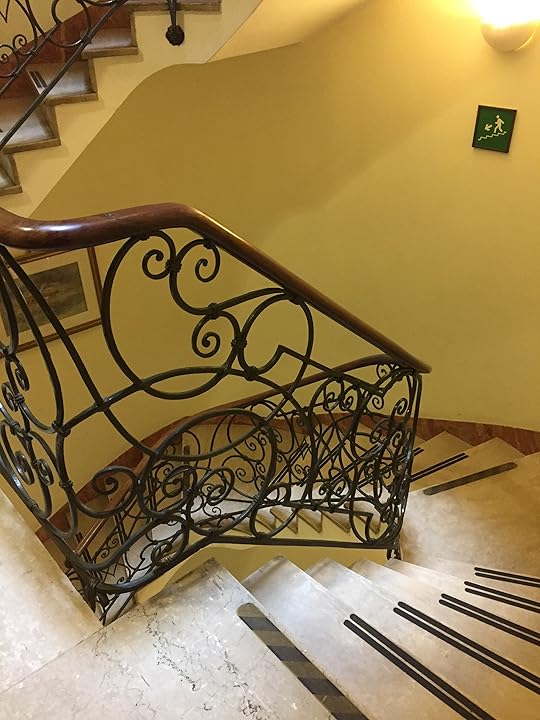 Every hotel we stayed at, had stairs like the one above. They all had one elevator smaller than a coat closet. At check in, we'd stack the five suitcases in the small space, hit the floor, and run up to meet our luggage. Also keep in mind when you are packing for the trip, if you plan to see the old churches or pretty much any place considered Holy, don't wear tank tops or shorts above the knee--they will ask you to leave or will stop you from entering. And if you carry a large bag or large purse, some of the exhibits will not let you bring it in. Some places have lockers but not all.Money--We had Euro on hand, but most places took our credit cards with no problem at all. We mostly used the Euro for taxi rides and small gelato stands.TransportationTaxis are probably your best bet in getting to the hotel from the airport unless you pack light and can walk it (as I mentioned above). I would NOT recommend renting a car. We thought about it, but I'm so glad we didn't. Drivers are crazy and there seems to be no lanes (well, I saw lane lines, but they drive right in the center). I seriously thought the ride from the airport to the hotel in Rome would be my last day on this earth.. and I grew up in California.Once you are in Italy and want to travel to the different cities, the train system is pretty awesome and inexpensive. But note, if you are traveling with large luggage, you'll have to spring for first class and even then the storage for large luggage is first come, first serve. I had to lift a large, heavy suitcase into the overhead and it was difficult. My hubby had to lift four up. If you're already settled into a hotel and are just taking the train for day trips, it's a great way to travel. For the day trips we rode, Trenitalia and for the trips between hotels we went with italo, which is the high speed train and does allow larger luggage. Transportation changes if you plan on visiting Venice. You still can take the train (we took italo) but if you're staying on the island or wanting to visit Saint Marcos Square, a water taxi or bus is going to be the next thing (no cars are allowed on the island, but really, you don't need one). We took the VAPORETTO, water bus. Yes, it will make several stops and will take longer than if you take a water taxi, but it's SOOO much cheaper. Since it was our first time in Italy, we enjoyed the views along the Grand Canal and didn't mind all the stops. The Vaporetto not only picks up from the train station, but to and from the airport. We were flying out of Venice super early and it was not a problem.
Every hotel we stayed at, had stairs like the one above. They all had one elevator smaller than a coat closet. At check in, we'd stack the five suitcases in the small space, hit the floor, and run up to meet our luggage. Also keep in mind when you are packing for the trip, if you plan to see the old churches or pretty much any place considered Holy, don't wear tank tops or shorts above the knee--they will ask you to leave or will stop you from entering. And if you carry a large bag or large purse, some of the exhibits will not let you bring it in. Some places have lockers but not all.Money--We had Euro on hand, but most places took our credit cards with no problem at all. We mostly used the Euro for taxi rides and small gelato stands.TransportationTaxis are probably your best bet in getting to the hotel from the airport unless you pack light and can walk it (as I mentioned above). I would NOT recommend renting a car. We thought about it, but I'm so glad we didn't. Drivers are crazy and there seems to be no lanes (well, I saw lane lines, but they drive right in the center). I seriously thought the ride from the airport to the hotel in Rome would be my last day on this earth.. and I grew up in California.Once you are in Italy and want to travel to the different cities, the train system is pretty awesome and inexpensive. But note, if you are traveling with large luggage, you'll have to spring for first class and even then the storage for large luggage is first come, first serve. I had to lift a large, heavy suitcase into the overhead and it was difficult. My hubby had to lift four up. If you're already settled into a hotel and are just taking the train for day trips, it's a great way to travel. For the day trips we rode, Trenitalia and for the trips between hotels we went with italo, which is the high speed train and does allow larger luggage. Transportation changes if you plan on visiting Venice. You still can take the train (we took italo) but if you're staying on the island or wanting to visit Saint Marcos Square, a water taxi or bus is going to be the next thing (no cars are allowed on the island, but really, you don't need one). We took the VAPORETTO, water bus. Yes, it will make several stops and will take longer than if you take a water taxi, but it's SOOO much cheaper. Since it was our first time in Italy, we enjoyed the views along the Grand Canal and didn't mind all the stops. The Vaporetto not only picks up from the train station, but to and from the airport. We were flying out of Venice super early and it was not a problem.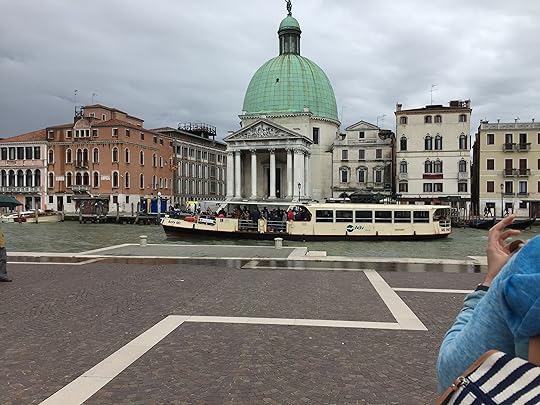
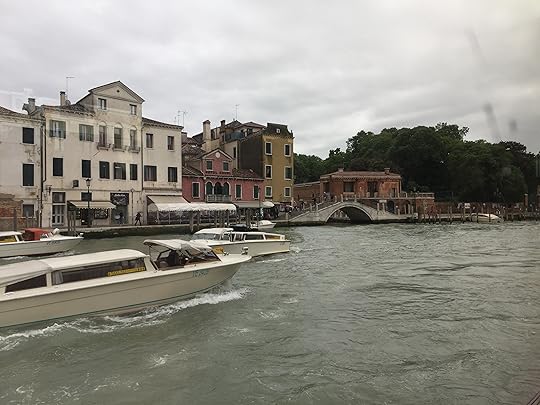 Hotels When looking for a hotel, it's important to know what sites you want to see and book something pretty central. Taxi drivers (well, all drivers) are scary and expensive (as I mentioned) if you take them everywhere. Walking was not a problem at all and you get to see so much more of the cities. If you have problems walking, Italy may not be for you. The terrain is very hilly and there are lots, I mean LOTS of stairs. I did not see many with baby strollers or even wheelchairs. No handicap bathrooms or ramps.
Hotels When looking for a hotel, it's important to know what sites you want to see and book something pretty central. Taxi drivers (well, all drivers) are scary and expensive (as I mentioned) if you take them everywhere. Walking was not a problem at all and you get to see so much more of the cities. If you have problems walking, Italy may not be for you. The terrain is very hilly and there are lots, I mean LOTS of stairs. I did not see many with baby strollers or even wheelchairs. No handicap bathrooms or ramps.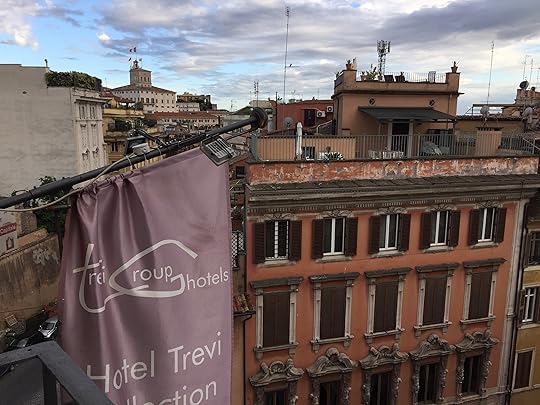 Our stay began in Rome at Hotel Trevi Collection. Above photo was a side view taken from our balcony. If you click the photo it will take you to their site and gallery. Their breakfast (included) was a great way to start off our day. The location couldn't have been more perfect. Steps away from the Trevi Fountain, less than a mile from the Colosseum (plus so many other things to see) and about a mile from the Vatican. The room was small and we had to share a bathroom but everyone had their own bed and the balcony view was great.
Our stay began in Rome at Hotel Trevi Collection. Above photo was a side view taken from our balcony. If you click the photo it will take you to their site and gallery. Their breakfast (included) was a great way to start off our day. The location couldn't have been more perfect. Steps away from the Trevi Fountain, less than a mile from the Colosseum (plus so many other things to see) and about a mile from the Vatican. The room was small and we had to share a bathroom but everyone had their own bed and the balcony view was great.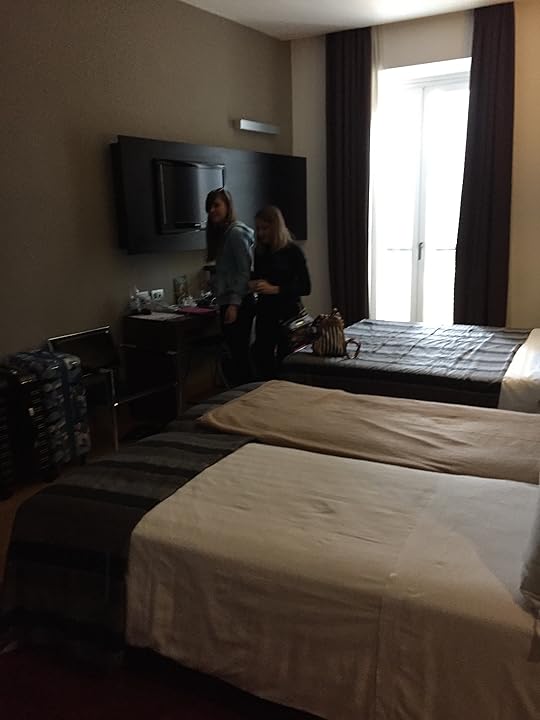 Florence was our second stay at hotel, Relais Uffizi. It was a decent sized apartment with two bedrooms, living room, one full bath, one half bath, living room, and full kitchen (although we paid the extra $$ for breakfast, since those staying in the apartment lofts do not include breakfast--totally worth paying for it). I loved the location in the heart of Florence but we did have a hard time finding the hotel because it was tucked in an alleyway (photo below). If you take a taxi, you'll be fine, but we walked from the train station to the hotel. Here we are trying to buzz the door to get into the entryway.
Florence was our second stay at hotel, Relais Uffizi. It was a decent sized apartment with two bedrooms, living room, one full bath, one half bath, living room, and full kitchen (although we paid the extra $$ for breakfast, since those staying in the apartment lofts do not include breakfast--totally worth paying for it). I loved the location in the heart of Florence but we did have a hard time finding the hotel because it was tucked in an alleyway (photo below). If you take a taxi, you'll be fine, but we walked from the train station to the hotel. Here we are trying to buzz the door to get into the entryway.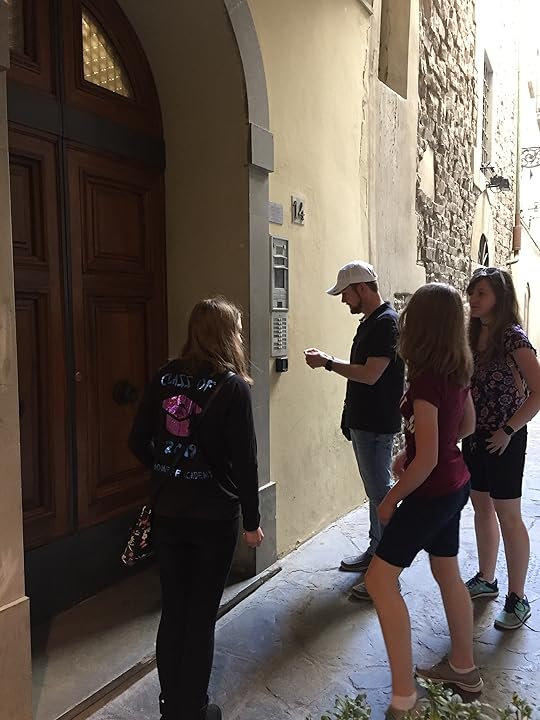 Side note: We took the train to Pisa one of the days while we stayed here. It was an easy ride and walk to leaning tower and that entire historical site. Totally worth the journey! Below is pictures of our room at the Relasis Uffizi.
Side note: We took the train to Pisa one of the days while we stayed here. It was an easy ride and walk to leaning tower and that entire historical site. Totally worth the journey! Below is pictures of our room at the Relasis Uffizi.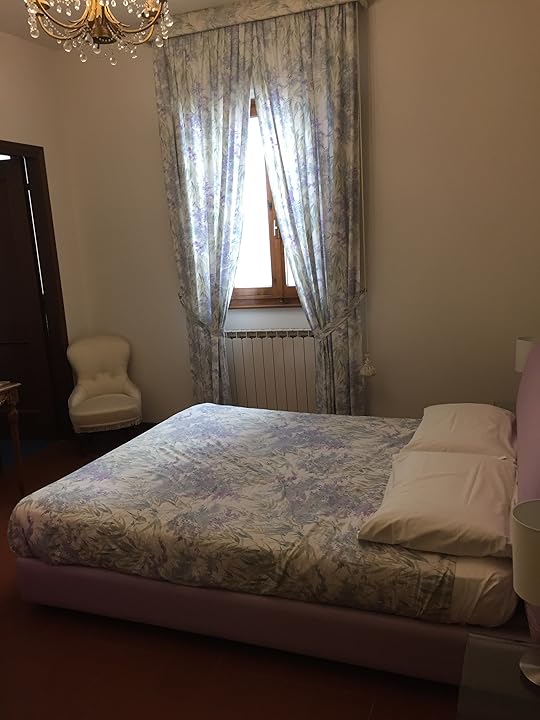
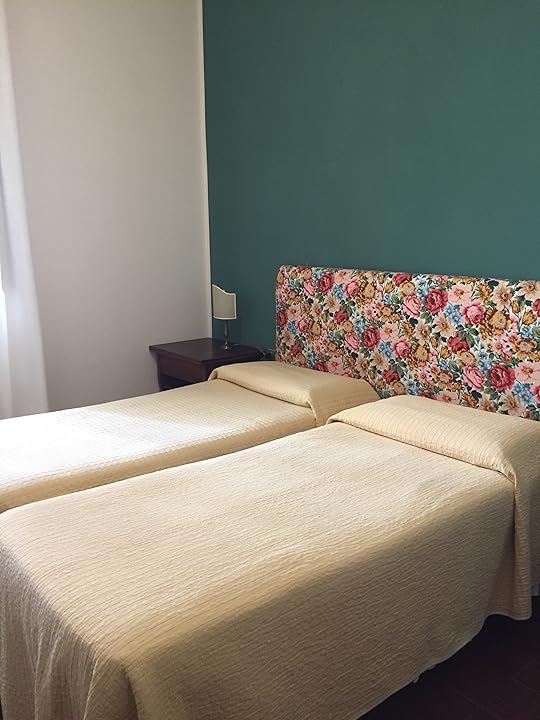
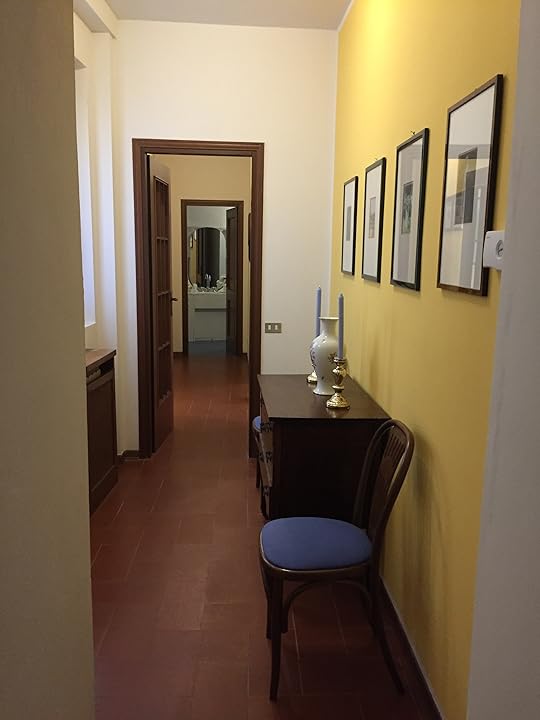 Our third stay took us to Bologna and to the Art Hotel Novecento. We stayed in one of the apartments and it was very updated and had an artistic designed. The shower was also a steam room. Who wouldn't love that.
Our third stay took us to Bologna and to the Art Hotel Novecento. We stayed in one of the apartments and it was very updated and had an artistic designed. The shower was also a steam room. Who wouldn't love that.


 Bologna wasn't my favorite place to visit, but I did enjoy our stay and were in a very nice, quiet courtyard.
Bologna wasn't my favorite place to visit, but I did enjoy our stay and were in a very nice, quiet courtyard.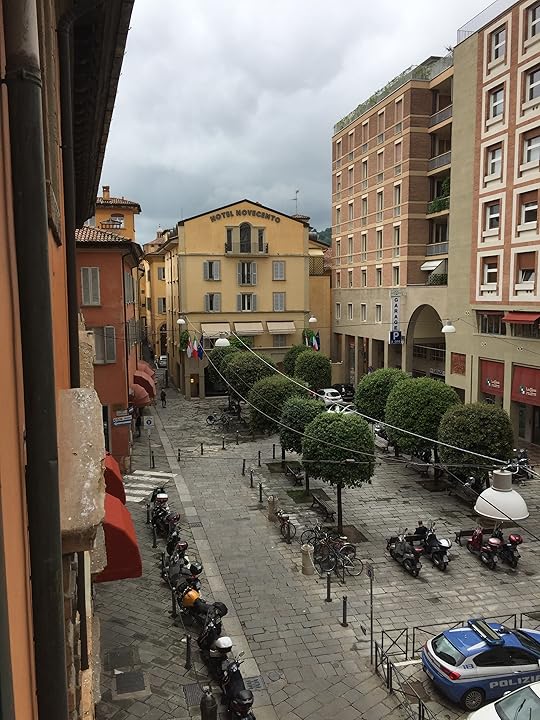
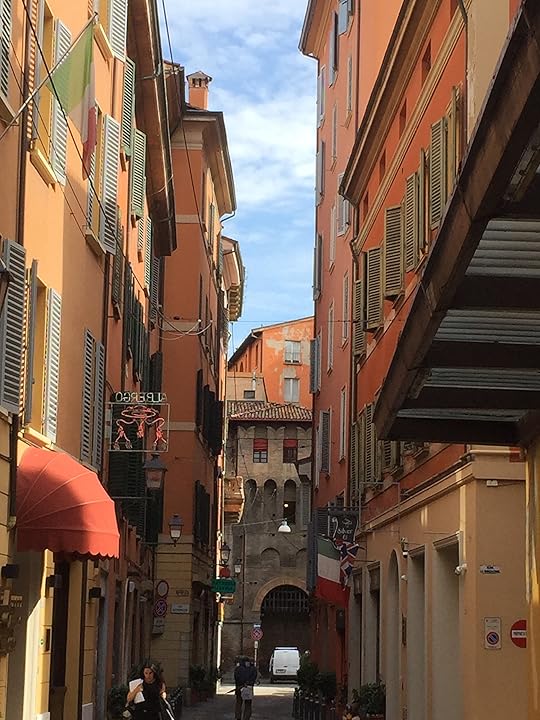 Finally, Venice and my favorite place of all.
Finally, Venice and my favorite place of all.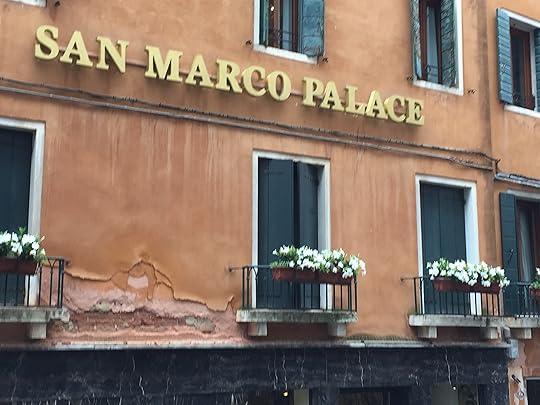 San Marco Palace is just steps way from Saint Marco Square and along one of the canals. We stayed in the family suite, where everyone had their own bed. So nice when you've been walking ten miles a day for over a week. Even better, our room had a balcony and the other room stretched across one of the canals.
San Marco Palace is just steps way from Saint Marco Square and along one of the canals. We stayed in the family suite, where everyone had their own bed. So nice when you've been walking ten miles a day for over a week. Even better, our room had a balcony and the other room stretched across one of the canals.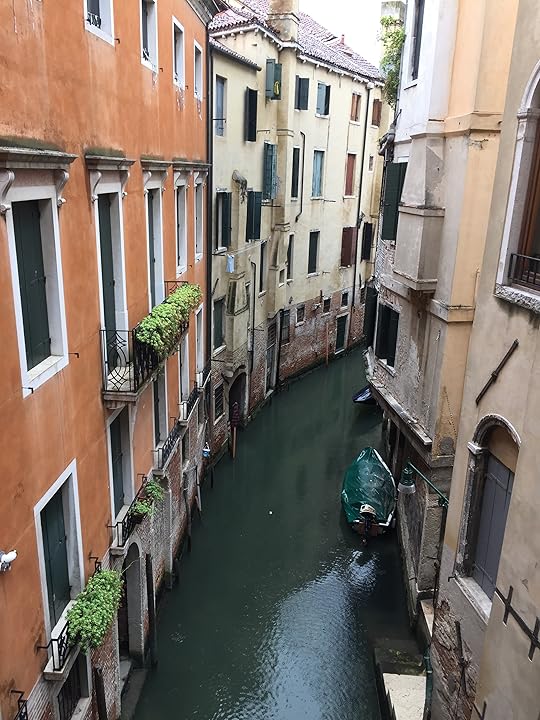
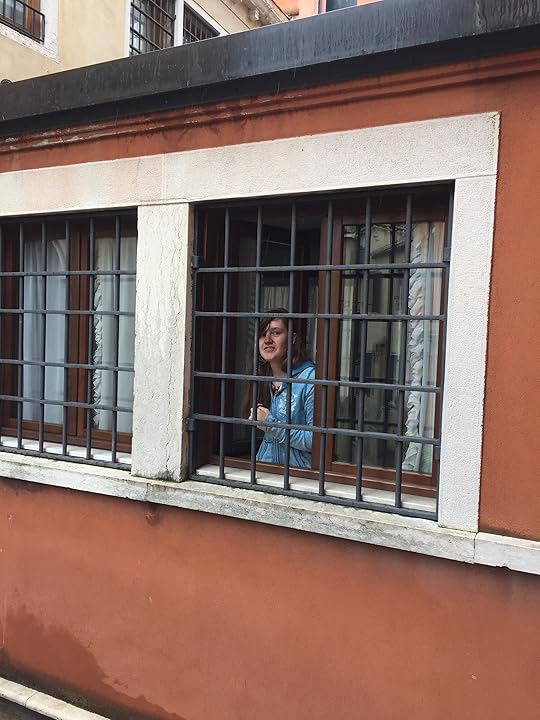
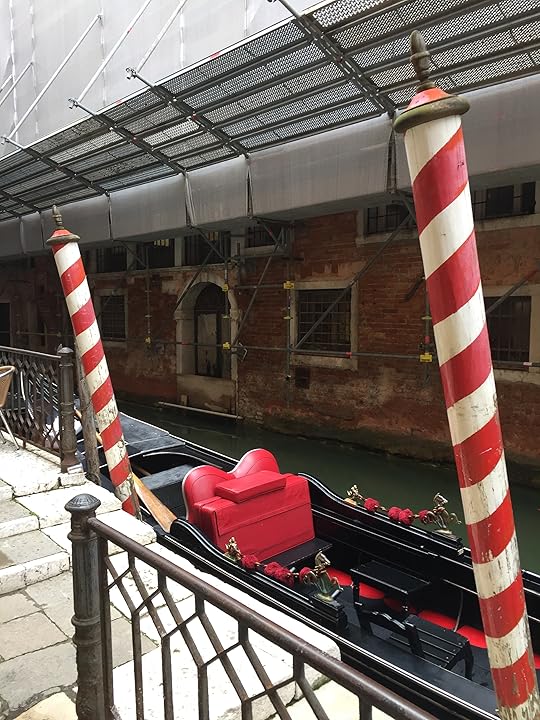 And since Gondola rides were $80 Euro per person for a 30 min ride, having a room off a frequently used canal, I got to hear the singing gondolier for free several times.
And since Gondola rides were $80 Euro per person for a 30 min ride, having a room off a frequently used canal, I got to hear the singing gondolier for free several times.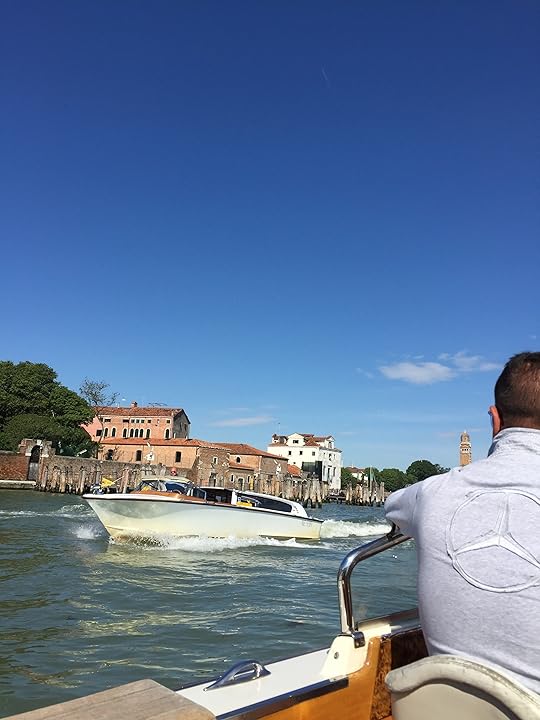
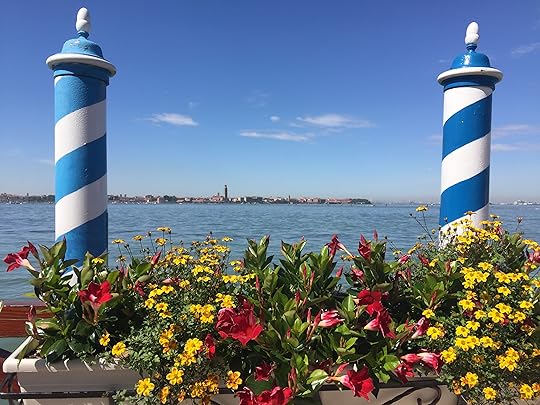 The hotel in Venice also gave us a free excursion to Murano, the Glass Island. Free water taxi to and from the Island was neat, but really all of it was a sales pitch to buy blown glass pieces. You get a demo and history of the company before a sales person leads you around the showrooms. It was quite beautiful and neat to see. I never felt pressured to buy anything. Our guide was awesome, but I'm sure he would have been happier if we were buyers.RestaurantsThe one thing you really want to do is experience Italy and local dishes. Pizza and pasta dishes are a given all over Italy, but certain cities have specalities. Bologna, for example, is known for it's Spaghetti alla Bolognese (which was delicious) gelato originated in Florence, and seafood is Venice. Below, we are eating at a restaurant in Rome, close to the Colosseum where we had pizza and pasta.
The hotel in Venice also gave us a free excursion to Murano, the Glass Island. Free water taxi to and from the Island was neat, but really all of it was a sales pitch to buy blown glass pieces. You get a demo and history of the company before a sales person leads you around the showrooms. It was quite beautiful and neat to see. I never felt pressured to buy anything. Our guide was awesome, but I'm sure he would have been happier if we were buyers.RestaurantsThe one thing you really want to do is experience Italy and local dishes. Pizza and pasta dishes are a given all over Italy, but certain cities have specalities. Bologna, for example, is known for it's Spaghetti alla Bolognese (which was delicious) gelato originated in Florence, and seafood is Venice. Below, we are eating at a restaurant in Rome, close to the Colosseum where we had pizza and pasta.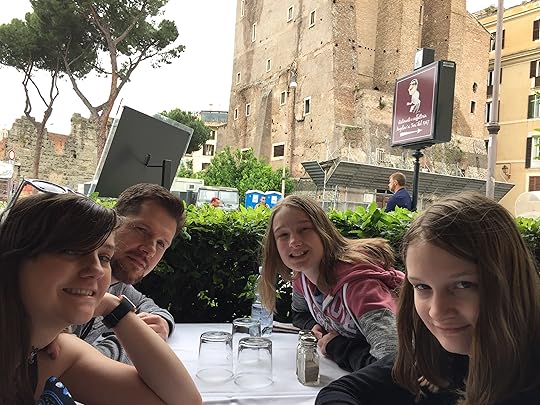
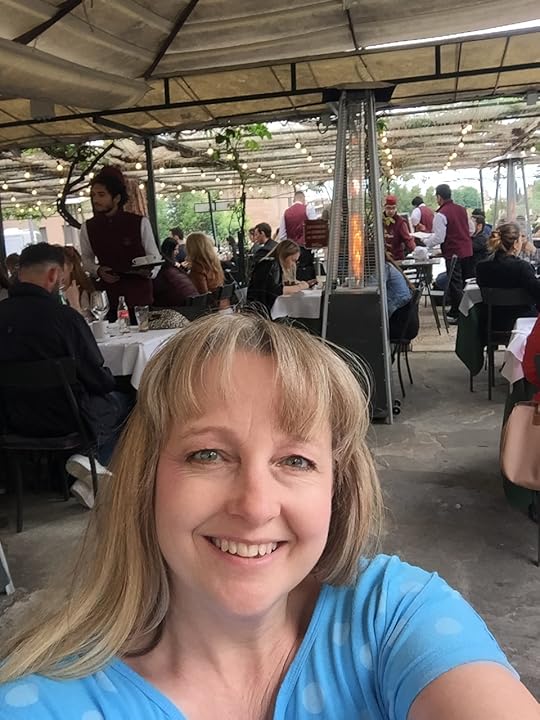 One great thing, breakfast was included in most of our hotel stays. Let me say, we all filled up, even my middle daughter who's not a big fan of breakfast foods.
One great thing, breakfast was included in most of our hotel stays. Let me say, we all filled up, even my middle daughter who's not a big fan of breakfast foods. 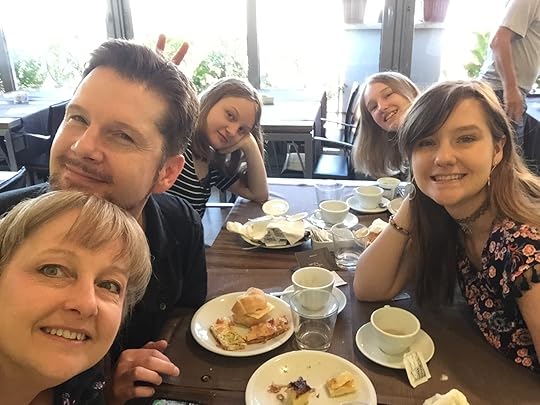
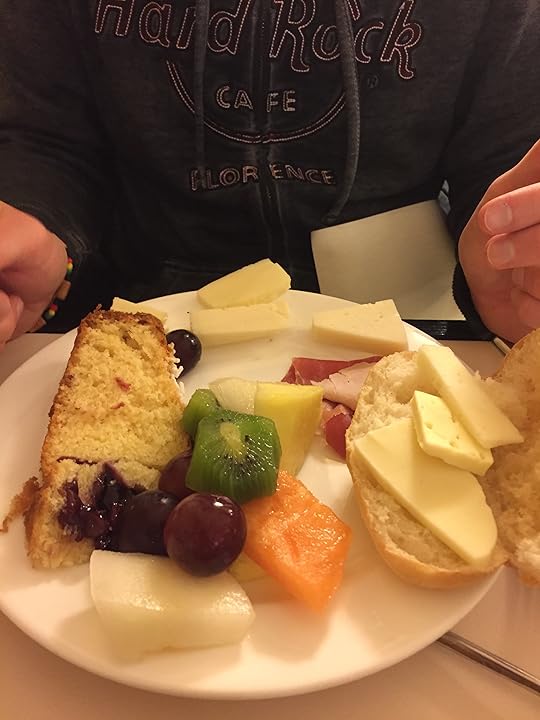
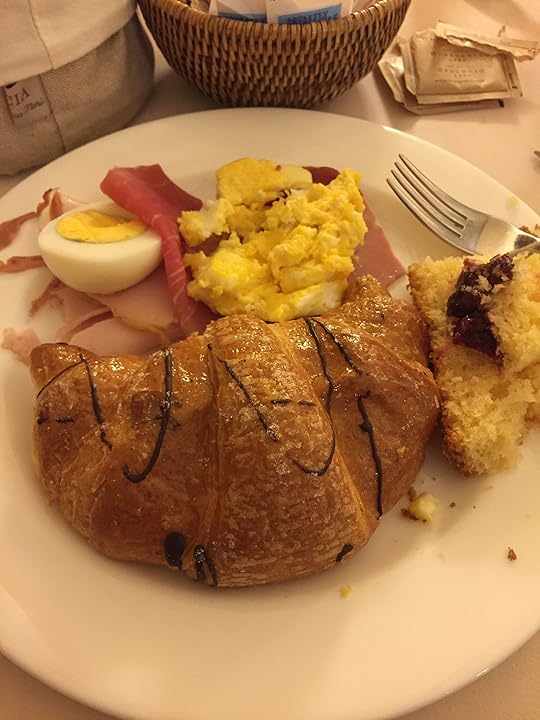 We pretty much ate two big meals a day (and of course dessert before heading back to the hotel). Our food was so much cheaper than when we stayed in Orlando.
We pretty much ate two big meals a day (and of course dessert before heading back to the hotel). Our food was so much cheaper than when we stayed in Orlando. 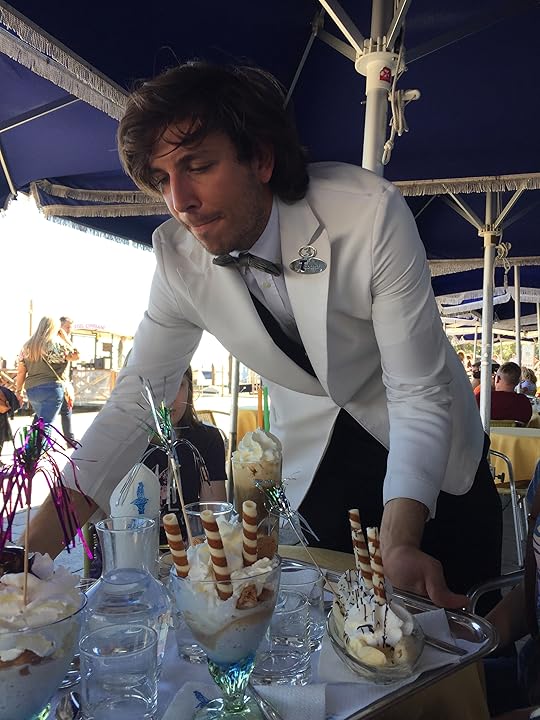 This guy reminded me of Adam Sandler. Just another tip before moving on, don't tip. Prices are already elevated for table service. We found out you can't go to a window and order then sit down (in same café/restaurant) to eat it. We did this with gelato one day and were asked to leave. The server explained the price difference, so of course we got up and ate while walking back to the hotel room. So no tipping and if you want to sit and rest your feet, don't order from a window or counter, let them wait on you. AttractionsOne thing I will say first off, we did not pay for any of the tours. To be honest, they weren't for us. We like doing what we want, when we want and tours are very structured with a lot of people. Most places, like the Colosseum, have English signs as well as Italian, or you can spend a few bucks more for self-guided battery operated recorders. One of the places we visited, you could download an app, but since we turned off our cellular data while there, it didn't work for us.
This guy reminded me of Adam Sandler. Just another tip before moving on, don't tip. Prices are already elevated for table service. We found out you can't go to a window and order then sit down (in same café/restaurant) to eat it. We did this with gelato one day and were asked to leave. The server explained the price difference, so of course we got up and ate while walking back to the hotel room. So no tipping and if you want to sit and rest your feet, don't order from a window or counter, let them wait on you. AttractionsOne thing I will say first off, we did not pay for any of the tours. To be honest, they weren't for us. We like doing what we want, when we want and tours are very structured with a lot of people. Most places, like the Colosseum, have English signs as well as Italian, or you can spend a few bucks more for self-guided battery operated recorders. One of the places we visited, you could download an app, but since we turned off our cellular data while there, it didn't work for us. Rome: The Trevi Fountain was our first stop. You can hear the roar of the rushing waters before this massive fountian comes into view. It's a beautiful sight. I had dreamed for several years of seeing this in person ever since I wrote the third Twisted Roots novel, Legacy. It's amazing how well I wrote the description based on Google Earth. Still, not the same as seeing it in person. It was awesome but get there early morning. The place is packed and the surrounding area is not very big.
Rome: The Trevi Fountain was our first stop. You can hear the roar of the rushing waters before this massive fountian comes into view. It's a beautiful sight. I had dreamed for several years of seeing this in person ever since I wrote the third Twisted Roots novel, Legacy. It's amazing how well I wrote the description based on Google Earth. Still, not the same as seeing it in person. It was awesome but get there early morning. The place is packed and the surrounding area is not very big.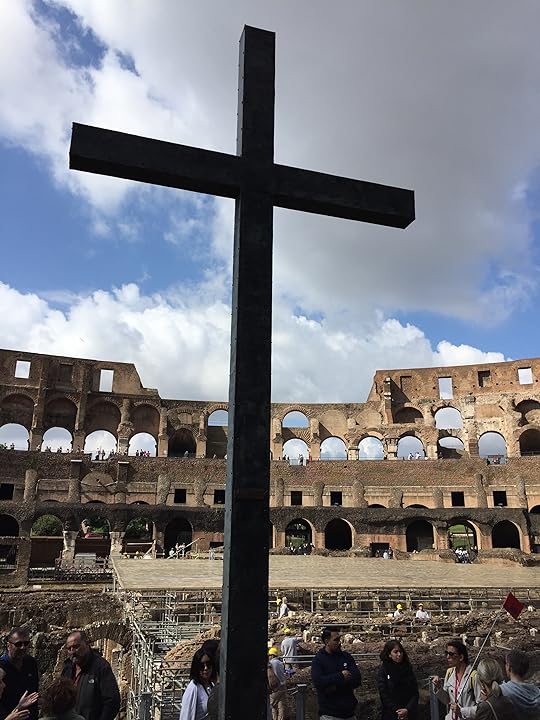 Rome: The Colosseum is a must for anyone. There are several options when seeing the Colosseum, but if you're wanting a more in-depth tour, you'd be happier booking a tour for your specific taste. For us just the general admission, which was amazingly inexpensive, worked. There are signs written in English explaining sections of the Colosseum and the history. No one is allowed on the floor because of excavations still going on.Note: Get there early in the day (you also go through security similar to the airport). They only allow so many in at a time and will hold the line until people or groups leave. I believe they take into count the tour groups, so if you buy a tour, you'll be fine. But keep in mind, tours are marked up like 4x times what you would pay for general admission. I just didn't think it was worth it. We got there early and had no issues.
Rome: The Colosseum is a must for anyone. There are several options when seeing the Colosseum, but if you're wanting a more in-depth tour, you'd be happier booking a tour for your specific taste. For us just the general admission, which was amazingly inexpensive, worked. There are signs written in English explaining sections of the Colosseum and the history. No one is allowed on the floor because of excavations still going on.Note: Get there early in the day (you also go through security similar to the airport). They only allow so many in at a time and will hold the line until people or groups leave. I believe they take into count the tour groups, so if you buy a tour, you'll be fine. But keep in mind, tours are marked up like 4x times what you would pay for general admission. I just didn't think it was worth it. We got there early and had no issues.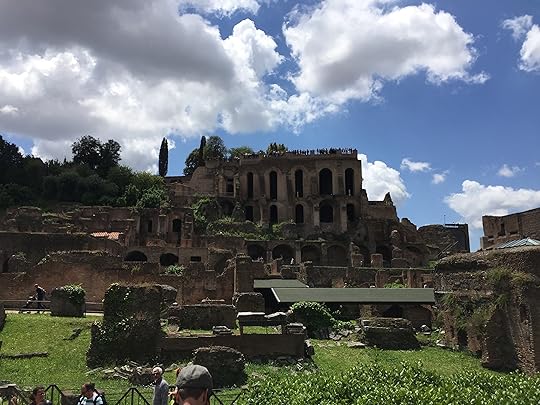 Right next to the Coliseum is Palatine Hill, which is a huge area. It's so beautiful with amazing gardens and old buildings. Be prepared though. We went right over to Palatine Hill from the Colosseum and we should have eaten before entering. We were starving and left before seeing all of it. There were some vending machines, but no snack stands or restaurants on the grounds.There is a lot to see in Rome and if you're on foot, like we were, you'll find all kinds of interesting places to see... many for free or very cheap. Another thing prices are cheaper or free for kids under 17 (not 10 or 12 like here). That saved us quite a bit of money. Other places we visited in Rome:-Roman Forum-Sistine Chapel-St Peter's Basilica-Raphael Rooms-The Pantheon-Piazza Navona-Trajan's Market-Churches (which again, do not wear shorts above the knee or tank top if you plan to enter them)-The Vatican (Which we decided not to go in. They were closing early and the line was long when we got there. Next time, we'll get there before they open and check the times. St. Peter's Basilica was next door, so we went there instead. It was awesome and FYI, there is a cafe at the top with an amazing view.
Right next to the Coliseum is Palatine Hill, which is a huge area. It's so beautiful with amazing gardens and old buildings. Be prepared though. We went right over to Palatine Hill from the Colosseum and we should have eaten before entering. We were starving and left before seeing all of it. There were some vending machines, but no snack stands or restaurants on the grounds.There is a lot to see in Rome and if you're on foot, like we were, you'll find all kinds of interesting places to see... many for free or very cheap. Another thing prices are cheaper or free for kids under 17 (not 10 or 12 like here). That saved us quite a bit of money. Other places we visited in Rome:-Roman Forum-Sistine Chapel-St Peter's Basilica-Raphael Rooms-The Pantheon-Piazza Navona-Trajan's Market-Churches (which again, do not wear shorts above the knee or tank top if you plan to enter them)-The Vatican (Which we decided not to go in. They were closing early and the line was long when we got there. Next time, we'll get there before they open and check the times. St. Peter's Basilica was next door, so we went there instead. It was awesome and FYI, there is a cafe at the top with an amazing view.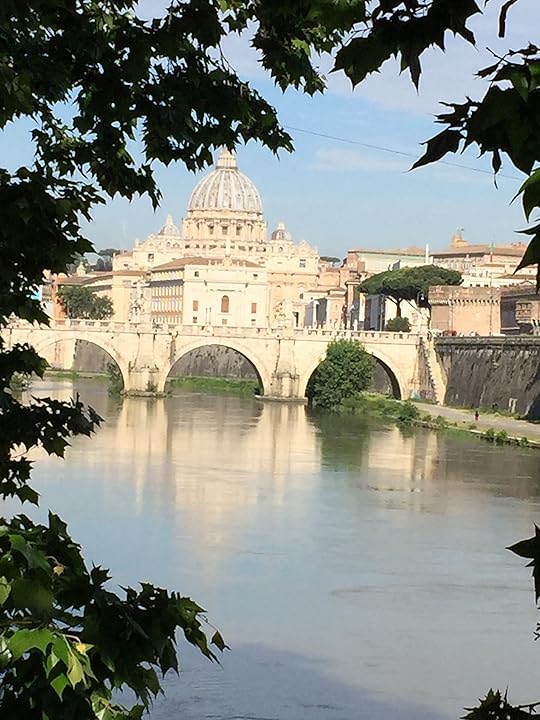
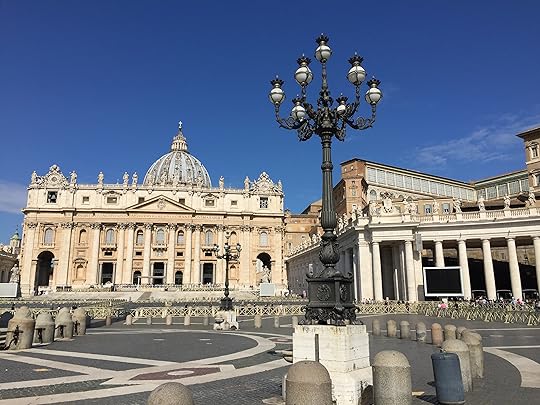 Florence: Pisa was a short train ride from our hotel and totally worth the trip. It's a beautiful walk from the train station to Piazza dei Miracoli also called the The Square of Miracles.
Florence: Pisa was a short train ride from our hotel and totally worth the trip. It's a beautiful walk from the train station to Piazza dei Miracoli also called the The Square of Miracles. 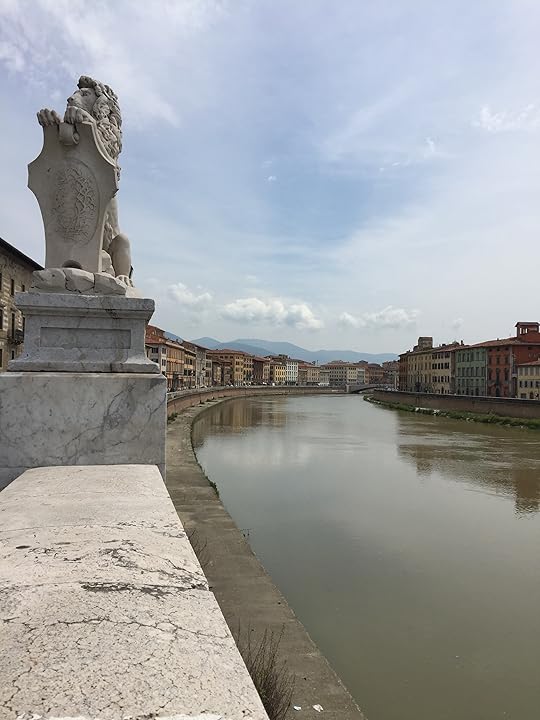
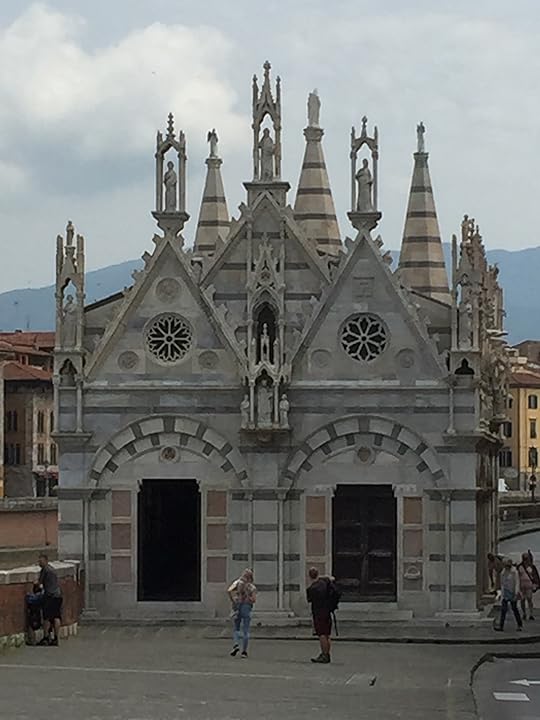 Of course you have to walk up the tower. It's kind of like walking up stairs, drunk as the lean thrusts your body from one side to the other. Be careful though, the marble steps are worn and slippery, but it's worth the view at the top.The guy in the first photo below, is a bit confused on the concept of holding up the tower.
Of course you have to walk up the tower. It's kind of like walking up stairs, drunk as the lean thrusts your body from one side to the other. Be careful though, the marble steps are worn and slippery, but it's worth the view at the top.The guy in the first photo below, is a bit confused on the concept of holding up the tower.
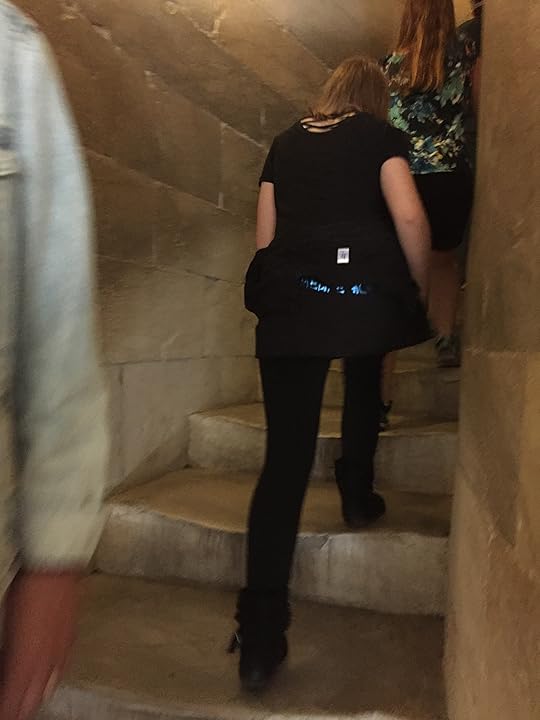
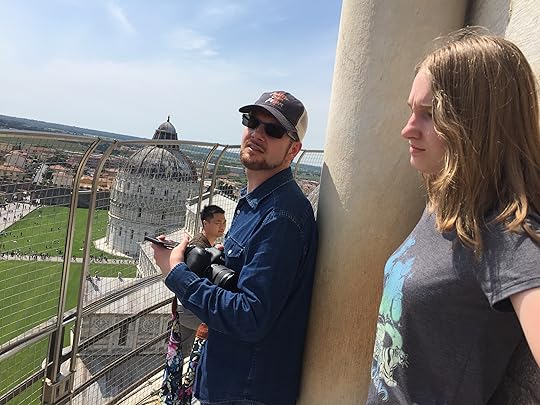
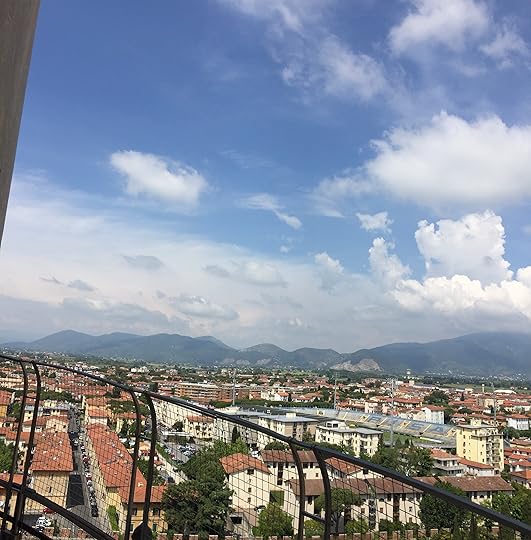 There are other things to do in the square, so plan on spending the day there. Florence is a beautiful city and there is a lot to see. Our hotel was located super close to the Piazza dei Miracoli. Lots of restaurants, fountains, museums and sculptures. If you plan to visit the Palazzo Vecchio and it's even a little drizzly, they will close the tower, so you may want to plan another day. If the marble steps get wet, it's too dangerous.
There are other things to do in the square, so plan on spending the day there. Florence is a beautiful city and there is a lot to see. Our hotel was located super close to the Piazza dei Miracoli. Lots of restaurants, fountains, museums and sculptures. If you plan to visit the Palazzo Vecchio and it's even a little drizzly, they will close the tower, so you may want to plan another day. If the marble steps get wet, it's too dangerous. 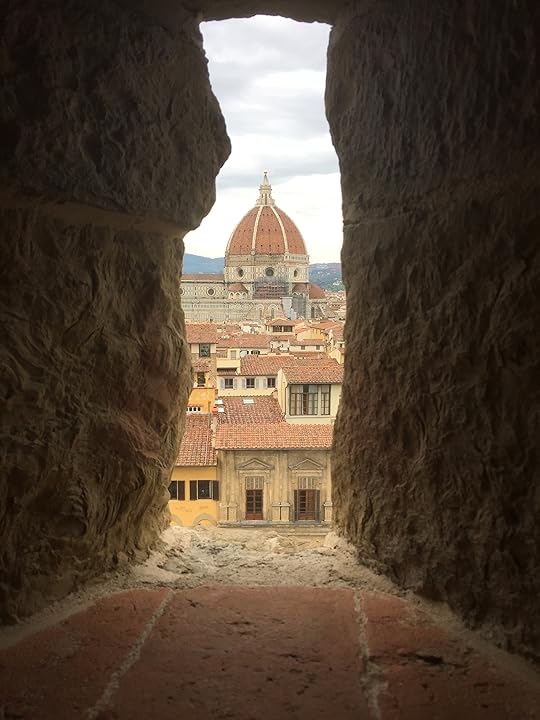
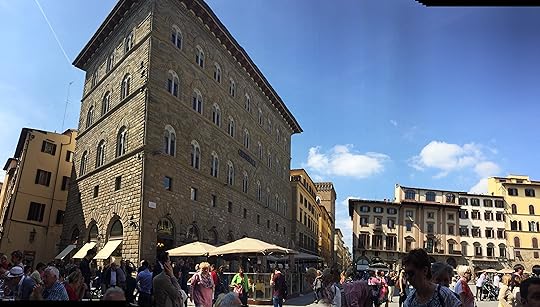 Bologna: I'll admit it wasn't my favorite city, however, it was my favorite meal. The city streets are lined with huge, beautiful outdoor hallways. I kept thinking how nice it would be to have those here in Colorado when it snows to keep the walkways between businesses clear.
Bologna: I'll admit it wasn't my favorite city, however, it was my favorite meal. The city streets are lined with huge, beautiful outdoor hallways. I kept thinking how nice it would be to have those here in Colorado when it snows to keep the walkways between businesses clear.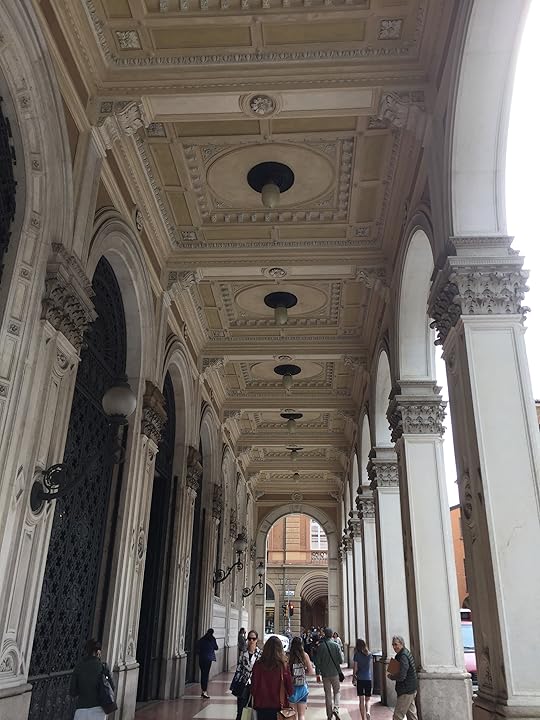
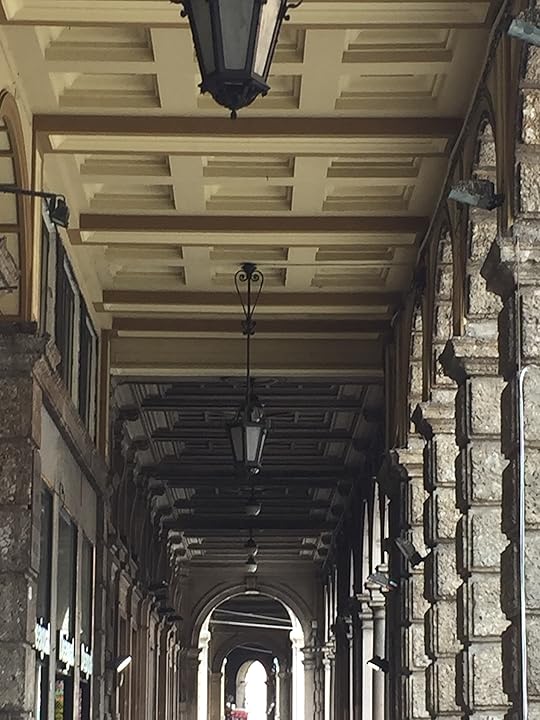 Bologna also had some cool art displays and we found a wonderful park while exploring.
Bologna also had some cool art displays and we found a wonderful park while exploring.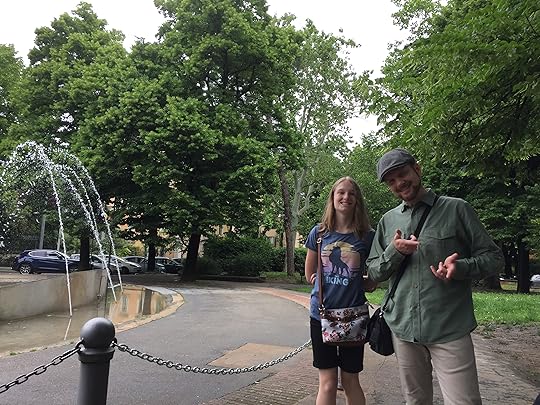
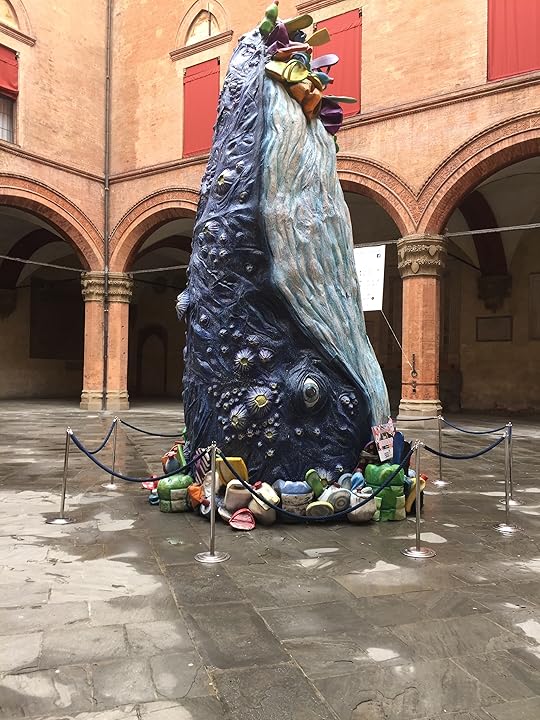

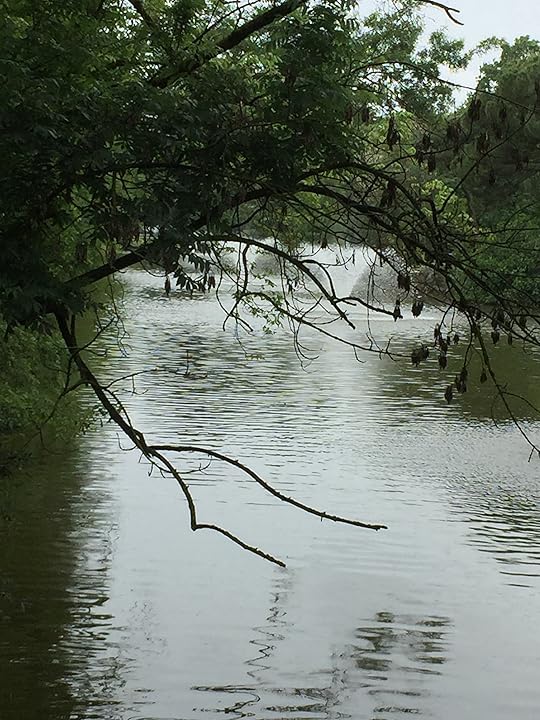 Venice: I loved Venice and what I looked forward to the most. But looking back, I wished we would have stayed one more day in Rome and one day less in Venice or would have researched more on the surrounding islands to visit. Our hotel couldn't haven't been better, like I mentioned in the hotel section. Saint Marcus square is the place to be.
Venice: I loved Venice and what I looked forward to the most. But looking back, I wished we would have stayed one more day in Rome and one day less in Venice or would have researched more on the surrounding islands to visit. Our hotel couldn't haven't been better, like I mentioned in the hotel section. Saint Marcus square is the place to be.
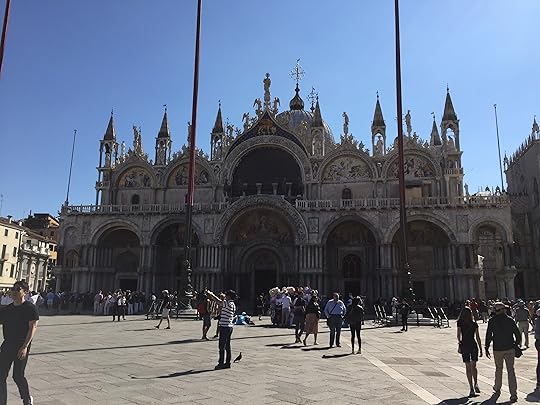 And of course there are no cars anywhere, which is nice, but be prepared for the large crowds. We watched cruise ships sailing on the Grand Canal to a docking port on the back side of the island. It was super busy mid-afternoon and the alley ways were tight with people. If you want the quiet moments in the square, get up early.
And of course there are no cars anywhere, which is nice, but be prepared for the large crowds. We watched cruise ships sailing on the Grand Canal to a docking port on the back side of the island. It was super busy mid-afternoon and the alley ways were tight with people. If you want the quiet moments in the square, get up early. 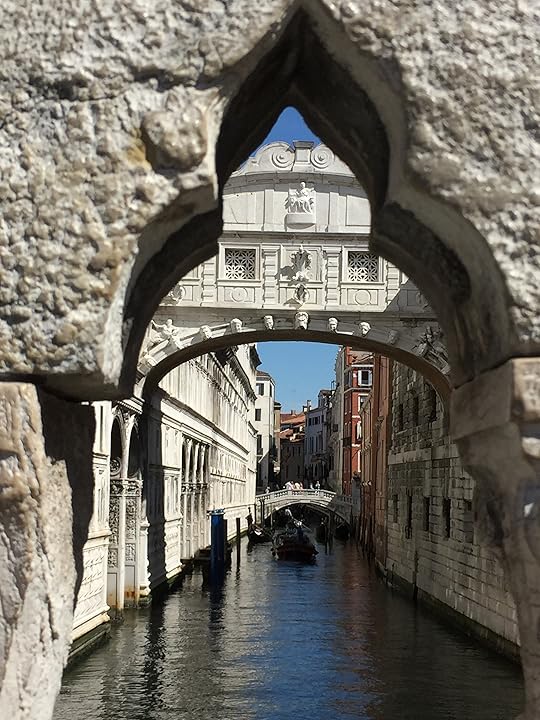
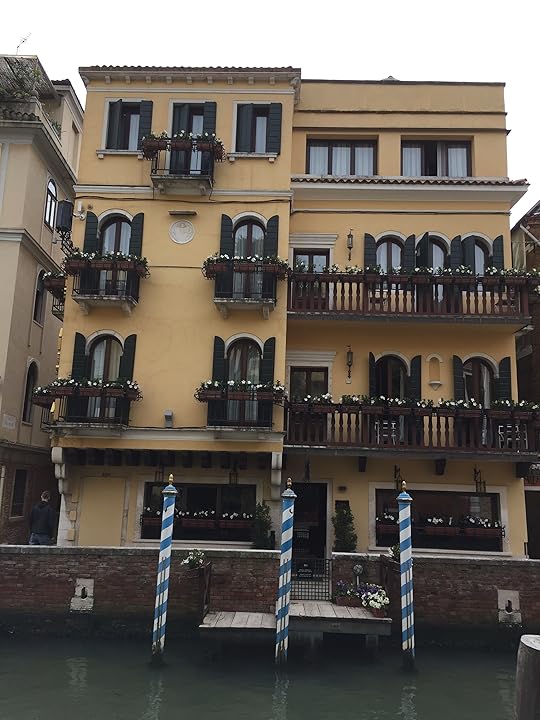
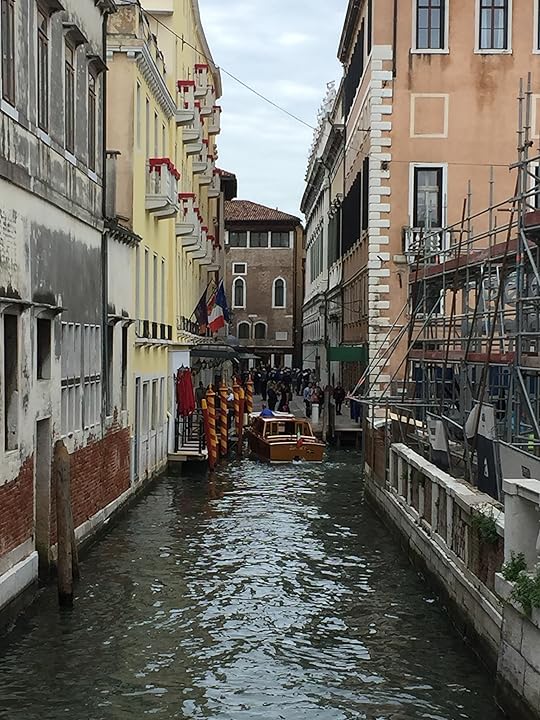
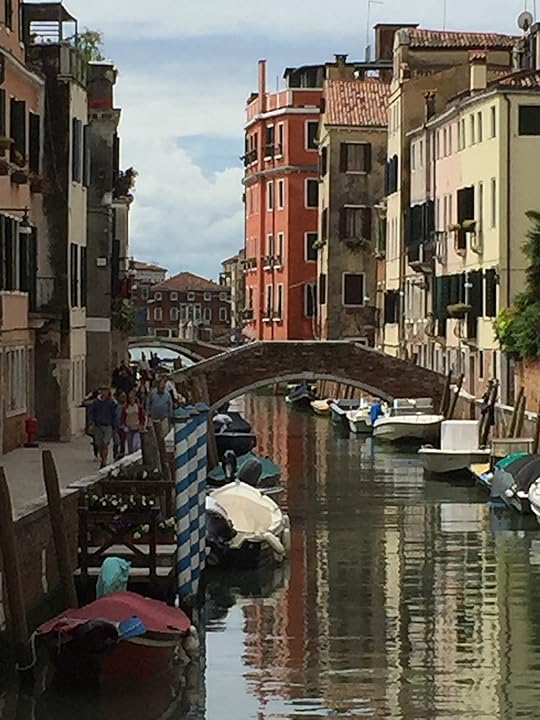 I will admit, although this was a vacation I had dreamed about for along time, I still had anxiety about visiting the unknown. Would I be able to speak to people, would we like the food, how will people treat us, how will we get around without renting a car, transportation to Venice… the list goes on. And now I can say there was nothing to worry about and it was easy peasy. For anyone getting ready to take this journey, I hope this blog was helpful and if you have any questions, I'd be happy to answer the best I can. As a writer, I hope to continue traveling and adding new experiences. Japan is next on our list. Oh boy!
I will admit, although this was a vacation I had dreamed about for along time, I still had anxiety about visiting the unknown. Would I be able to speak to people, would we like the food, how will people treat us, how will we get around without renting a car, transportation to Venice… the list goes on. And now I can say there was nothing to worry about and it was easy peasy. For anyone getting ready to take this journey, I hope this blog was helpful and if you have any questions, I'd be happy to answer the best I can. As a writer, I hope to continue traveling and adding new experiences. Japan is next on our list. Oh boy!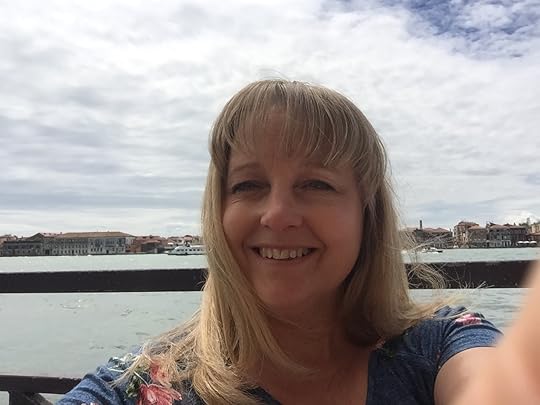 About the writer: As a young, vivacious reader, Shelly spent most of her time, either in the restricted reading section of the library, or scribbling away in journals. Shelly’s first novel A Light into the Darkness earned a Puddly Award in 2013 and in 2015 was nominated for Family Fiction's top ten books. In 2016, she completed and published her third novel in the Twisted Roots series and started teaching creative writing classes at High Country Home Educators. Current project she is working on is an apocalyptic romance which can only be described as a cross between Left Behind and Mad Max Beyond Thunder-dome. Shelly lives in Colorado with her husband Tim, three daughters, and three rescue dogs
About the writer: As a young, vivacious reader, Shelly spent most of her time, either in the restricted reading section of the library, or scribbling away in journals. Shelly’s first novel A Light into the Darkness earned a Puddly Award in 2013 and in 2015 was nominated for Family Fiction's top ten books. In 2016, she completed and published her third novel in the Twisted Roots series and started teaching creative writing classes at High Country Home Educators. Current project she is working on is an apocalyptic romance which can only be described as a cross between Left Behind and Mad Max Beyond Thunder-dome. Shelly lives in Colorado with her husband Tim, three daughters, and three rescue dogs
September 13, 2016
World Building
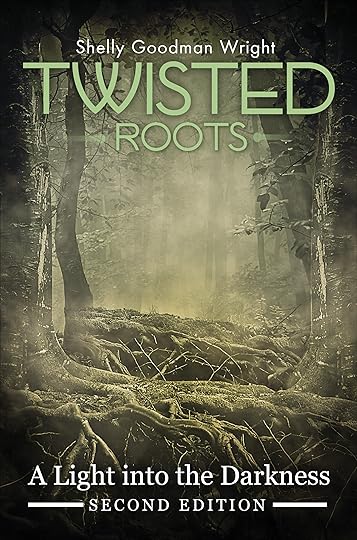 World BuildingLet’s start with world building. Keeping a record of what your world looks like, feels like, smells like, and sounds like is only part of your story. Depending on where the world is, you may need to establish rules--meaning the world isn’t of our world as we know it.For example, if you’re creating a world where the sun burns out or is destroyed, researching theories of how it would affect the earth would need to done. Or say your characters are in space. Probing for information about current travel in space or theories of future machines that would make it possible, would be a good idea. Of course once that information is obtained, writers can take it and twist it any way they want.There is always an element of truth in any fictional writing.Where to begin...Write EVERYTHING about your WORLD even if the information written down is not used. Readers do not want to be bogged down with too much information. The only information needed is what moves the story forward and is necessary. My story took place in the Okefenokee Swamp in Georgia. I researched the plants and wildlife, the landscapes, and the history. Some I used, some I didn’t use, some I cut in the editing steps.Getting started with your world.What does it look like?Is there foliage/trees/dessert?Fantastical?Real?What kinds of smells are there?How is the air?Is it heavy?Is it hard to breathe?Is it salty?What sounds would be heard?Nature? Space?What makes this world different from reality?What’s the mood of the world?Everyone happy?Oppressed? Gloomy?Are there animals?Real?Fictional?Does the world have cities, towns, kingdoms, leagues, quadrants, etc?Research still needed to create your world?Draw a map.
World BuildingLet’s start with world building. Keeping a record of what your world looks like, feels like, smells like, and sounds like is only part of your story. Depending on where the world is, you may need to establish rules--meaning the world isn’t of our world as we know it.For example, if you’re creating a world where the sun burns out or is destroyed, researching theories of how it would affect the earth would need to done. Or say your characters are in space. Probing for information about current travel in space or theories of future machines that would make it possible, would be a good idea. Of course once that information is obtained, writers can take it and twist it any way they want.There is always an element of truth in any fictional writing.Where to begin...Write EVERYTHING about your WORLD even if the information written down is not used. Readers do not want to be bogged down with too much information. The only information needed is what moves the story forward and is necessary. My story took place in the Okefenokee Swamp in Georgia. I researched the plants and wildlife, the landscapes, and the history. Some I used, some I didn’t use, some I cut in the editing steps.Getting started with your world.What does it look like?Is there foliage/trees/dessert?Fantastical?Real?What kinds of smells are there?How is the air?Is it heavy?Is it hard to breathe?Is it salty?What sounds would be heard?Nature? Space?What makes this world different from reality?What’s the mood of the world?Everyone happy?Oppressed? Gloomy?Are there animals?Real?Fictional?Does the world have cities, towns, kingdoms, leagues, quadrants, etc?Research still needed to create your world?Draw a map.
September 2, 2016
Keep it Simple--Get Writing
 Every writer has story ideas. From animals that talk to flying cars, we allow our imagination to wander the possibilities. Some writers have visions of living on Mars, while others take the world we live in and twist the reality in any way they chose. That’s what I like most about writing. Writers can take their readers anywhere.Although we have this ability, getting our story on paper to captivate our readers requires specific steps followed by a lot of editing. Writing is a craft. We start off as a novice, become an apprentice, and end up a master. Most writers never make it past the novice because they rush the process.So how do we get started? Or we already started, but now we’re stuck? These steps will help whether you’re just getting started or already have a story.Write one sentence describing the novel.Include the setting, the hero and what he/she is after, and the villain (or what is stopping the hero from accomplishing the goal). Use no more than 15 words.Now expand the sentence into a paragraph by adding more details needed to set-up the story.This includes the main plot points of the story (like a 3-act play) and the ending of the story.There are several different methods writers use to write. I personally do the first two steps because it does help when it comes to writing the back of the book blurb or pitching to an agent. I always have to fine tune it once my novel is done, but the main idea is there and I’m not distracted by all the other events that happen in the novel.Now that you have a general idea for the story, it’s time to go deeper. We call this probing. We’ll be going deeper into describing our characters and the world in which they live. Some writers (like me) write as they go. Once I have the general paragraph written, I begin to expand the story.Next blog: World Building
Every writer has story ideas. From animals that talk to flying cars, we allow our imagination to wander the possibilities. Some writers have visions of living on Mars, while others take the world we live in and twist the reality in any way they chose. That’s what I like most about writing. Writers can take their readers anywhere.Although we have this ability, getting our story on paper to captivate our readers requires specific steps followed by a lot of editing. Writing is a craft. We start off as a novice, become an apprentice, and end up a master. Most writers never make it past the novice because they rush the process.So how do we get started? Or we already started, but now we’re stuck? These steps will help whether you’re just getting started or already have a story.Write one sentence describing the novel.Include the setting, the hero and what he/she is after, and the villain (or what is stopping the hero from accomplishing the goal). Use no more than 15 words.Now expand the sentence into a paragraph by adding more details needed to set-up the story.This includes the main plot points of the story (like a 3-act play) and the ending of the story.There are several different methods writers use to write. I personally do the first two steps because it does help when it comes to writing the back of the book blurb or pitching to an agent. I always have to fine tune it once my novel is done, but the main idea is there and I’m not distracted by all the other events that happen in the novel.Now that you have a general idea for the story, it’s time to go deeper. We call this probing. We’ll be going deeper into describing our characters and the world in which they live. Some writers (like me) write as they go. Once I have the general paragraph written, I begin to expand the story.Next blog: World Building
August 12, 2016
Finding the Right Writing Group
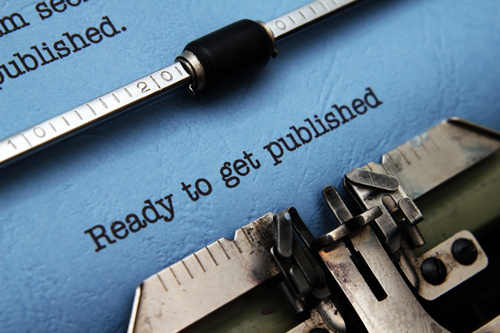 The road to publication is an endurance race. We prepare. We stretch our writing muscles. We take a hard look at our mistakes and how to fix them. We practice, practice, practice until we get it right. The one thing we don’t do—we don’t give up.When I started writing, I didn’t get a lot of encouragement. Although liked by my teachers for my effort, I never did well in school and my home life…well let’s just say it was dysfunctional.Jumping ahead into my late 30’s, the passion for writing returned. My situation had changed from no support to an abundance of support. The feeling of self-doubt still lingered over my head like a dark cloud, only I wouldn’t let it consume me.Once I finished the novel, I searched online for what to do next. After hours of reading editor blogs and various other writing sources, I began searching for local writing groups to join.The best thing I ever did.A year after joining a group, I landed my first short story publication and then shortly after I contracted my first novel. Early this year, I signed my fifth publication (third novel in the Twisted Roots Saga) set to release late fall 2016.I endured! I prepared. I stretched my writing muscles by taking a hard look at my manuscript. I learned how to fix them and then I rewrote, reworked, and polished—over and over again.How does this help you?First know not all writing groups are the same. Find one that works for you. I realized after a few years had passed, the group I was in stopped working for me. It was great for new writers, but I had grown so much, I needed something more intense.Things you’ll want to know/ask:What is the format of the meetings?(Oral critique, line editing, discussion, topical, write-ins)Has anyone in the group been published?Is there a trail period?How often do they meet?What is expected from you?Trail periods are great. This gives you time to observe the dynamics of the group and know if it’s a good fit.A few tips on evaluating a group:Are they tough? If everyone goes around the table saying how great everyone’s stories are, there’s a problem. There is always something that needs attention.Is everyone participating? Huge red flags if the majority of the members are NOT participating.When they give feedback, are they specific? If they like something, do they explain why? If they don’t understand, do they offer suggestions on how to fix it?Do the people in the group get along? This is important because you are trusting your little darlings with people you don’t know—yet. However, remember, they are doing the same thing.Blessings,Shelly
The road to publication is an endurance race. We prepare. We stretch our writing muscles. We take a hard look at our mistakes and how to fix them. We practice, practice, practice until we get it right. The one thing we don’t do—we don’t give up.When I started writing, I didn’t get a lot of encouragement. Although liked by my teachers for my effort, I never did well in school and my home life…well let’s just say it was dysfunctional.Jumping ahead into my late 30’s, the passion for writing returned. My situation had changed from no support to an abundance of support. The feeling of self-doubt still lingered over my head like a dark cloud, only I wouldn’t let it consume me.Once I finished the novel, I searched online for what to do next. After hours of reading editor blogs and various other writing sources, I began searching for local writing groups to join.The best thing I ever did.A year after joining a group, I landed my first short story publication and then shortly after I contracted my first novel. Early this year, I signed my fifth publication (third novel in the Twisted Roots Saga) set to release late fall 2016.I endured! I prepared. I stretched my writing muscles by taking a hard look at my manuscript. I learned how to fix them and then I rewrote, reworked, and polished—over and over again.How does this help you?First know not all writing groups are the same. Find one that works for you. I realized after a few years had passed, the group I was in stopped working for me. It was great for new writers, but I had grown so much, I needed something more intense.Things you’ll want to know/ask:What is the format of the meetings?(Oral critique, line editing, discussion, topical, write-ins)Has anyone in the group been published?Is there a trail period?How often do they meet?What is expected from you?Trail periods are great. This gives you time to observe the dynamics of the group and know if it’s a good fit.A few tips on evaluating a group:Are they tough? If everyone goes around the table saying how great everyone’s stories are, there’s a problem. There is always something that needs attention.Is everyone participating? Huge red flags if the majority of the members are NOT participating.When they give feedback, are they specific? If they like something, do they explain why? If they don’t understand, do they offer suggestions on how to fix it?Do the people in the group get along? This is important because you are trusting your little darlings with people you don’t know—yet. However, remember, they are doing the same thing.Blessings,Shelly
May 16, 2016
Beta Readers--3 Questions to Ask
 As writers, we all want to write something amazing. We want the reader to emerge into the worlds we created and end with a hunger for more. Whether it’s to entertain, teach, or enlighten, our goals are the same.So how to do we get to that point? How do we grow in the craft of writing?An article on the Guilford College website explains one useful method is peer editing:“One of the best ways to improve as a writer--other than through practice, practice, practice--is by consciously using the criteria of excellent writing to make judgments about what is good in a piece of writing and what is not and then applying those criteria to one's own work.” (http://www.guilford.edu/about_guilfor... years ago, when I finished the first draft of “A Light into the Darkness” I passed it along to a few friends. Although getting initial feedback was helpful for me, not all ‘friends’ will give you the hard, honest feedback. When I first started this process, I joined a writing group. Exchanging feedback for feedback, ties into the article above. I not only learned a lot about my own prose, but learned so much more from critiquing others.However, now that I’m my fourth novel with a loyal fan base following (and not a lot of time to devote to a group), I rely on beta readers for feedback. I’m pretty picky on beta readers. A reader who barely marks up the manuscript, I probably won’t ask them to help me on the next project.What should you ask of a beta reader?Honest Feedback—the more a manuscript is marked up, the more potential there is to make the writing stronger.If it’s a first draft, ask for conceptual editing—Flow/pace, consistencies, characters, descriptions, etc. Someone who reads a lot is a perfect candidate.For short stories, ask the beta to read the entire piece BEFORE making comments—For novels, read the chapter before making comments.As the writer, always keep in mind YOU’RE the author. Our natural reaction to ‘bad news’ is to get hurt or angry. My advice is to read through the comments and then put the manuscript away for a couple of days. It’s usually then I realize they are right and figure out what I can do to make it better. It’s not always the case, so if you disagree with the beta (and I suggest you use at least five or more), it’s your call. However, try to see it from their perspective (especially if more than one person points to the same issue).Some aspiring writers I’ve met at conventions and events, have told me it terrifies them to have others read their work. You might be one of those. But I tell you, once it’s out there for the public, the flood gates of critiques and opinions will come at you. It’s much better to hear it from friends and be able to fine tune it. Even though I have a publisher who does the professional editing, I still work with betas. I want it the best I can get it BEFORE the world sees it.This step will set you apart from the thousands trying to get published (or self-published newbies).
As writers, we all want to write something amazing. We want the reader to emerge into the worlds we created and end with a hunger for more. Whether it’s to entertain, teach, or enlighten, our goals are the same.So how to do we get to that point? How do we grow in the craft of writing?An article on the Guilford College website explains one useful method is peer editing:“One of the best ways to improve as a writer--other than through practice, practice, practice--is by consciously using the criteria of excellent writing to make judgments about what is good in a piece of writing and what is not and then applying those criteria to one's own work.” (http://www.guilford.edu/about_guilfor... years ago, when I finished the first draft of “A Light into the Darkness” I passed it along to a few friends. Although getting initial feedback was helpful for me, not all ‘friends’ will give you the hard, honest feedback. When I first started this process, I joined a writing group. Exchanging feedback for feedback, ties into the article above. I not only learned a lot about my own prose, but learned so much more from critiquing others.However, now that I’m my fourth novel with a loyal fan base following (and not a lot of time to devote to a group), I rely on beta readers for feedback. I’m pretty picky on beta readers. A reader who barely marks up the manuscript, I probably won’t ask them to help me on the next project.What should you ask of a beta reader?Honest Feedback—the more a manuscript is marked up, the more potential there is to make the writing stronger.If it’s a first draft, ask for conceptual editing—Flow/pace, consistencies, characters, descriptions, etc. Someone who reads a lot is a perfect candidate.For short stories, ask the beta to read the entire piece BEFORE making comments—For novels, read the chapter before making comments.As the writer, always keep in mind YOU’RE the author. Our natural reaction to ‘bad news’ is to get hurt or angry. My advice is to read through the comments and then put the manuscript away for a couple of days. It’s usually then I realize they are right and figure out what I can do to make it better. It’s not always the case, so if you disagree with the beta (and I suggest you use at least five or more), it’s your call. However, try to see it from their perspective (especially if more than one person points to the same issue).Some aspiring writers I’ve met at conventions and events, have told me it terrifies them to have others read their work. You might be one of those. But I tell you, once it’s out there for the public, the flood gates of critiques and opinions will come at you. It’s much better to hear it from friends and be able to fine tune it. Even though I have a publisher who does the professional editing, I still work with betas. I want it the best I can get it BEFORE the world sees it.This step will set you apart from the thousands trying to get published (or self-published newbies).
May 12, 2016
Breaking the Chains...
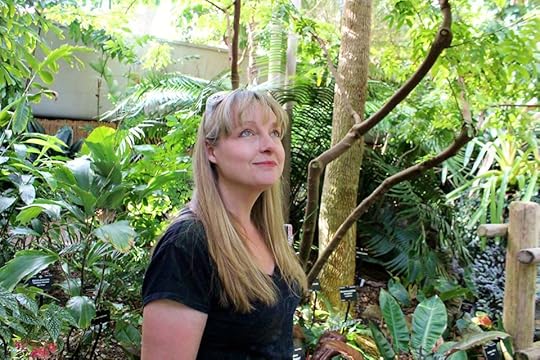 In 2008, the thought of being a novelist came back to me. I don't remember when I first started writing, but I do remember the first time I thought about becoming an author. I read a lot as a kid. It was my escape, my refuge away from a dysfunctional family life. My sixth grade year--a hard year--I spent every free hour reading. I devoured book after book. Each time one story ended, my heart sunk until I was captivated by another story. It was after reading a particular series, I thought "I want to create worlds for a reader to escape into."Mostly my writings stayed in notebooks I kept in my hope chest--never to see the light of day. My junior year in High School, my English teacher entered a short story I wrote for class into a contest. I won second place. I will always be grateful to Mrs. Mary Martin for her encouragement.Unfortunately my High School counselors weren't as encouraging. See, I wasn't a great student. I worked hard, but I struggled just to get passing grades. So when I started college, just trying hard wasn't enough to earn my degree. I'd learn years later, with my own children, I struggled with a form of dyslexia.Back to 2008, the characters in my head, quiet for so long, were stirring. With the support of my husband, in the Spring of 2009 I began writing "Something in the Swamp" which would later change to "Twisted Roots; A Light into the Darkness".When I began the journey, I did not know the story would need to be told in three books. I just wrote. No planning, no story board, no outline of any kind--I wrote until the characters stopped talking.Meanwhile, other characters, in new stories began their chatter. I've written several short stories (published in anthologies), first draft novels (Inhabitation & The Road to Nowhere) and there are more stories in my head waiting for their turn to make it into a WORD document.The title of my blog post is Breaking the Chains.Chains are the the fear that holds us back from following our dreams. It's the voice of lies saying "You can't do this". I'm here to say you can do it! My first publication came out just before my 40th birthday. It took me a long time to break free and follow my dreams.
In 2008, the thought of being a novelist came back to me. I don't remember when I first started writing, but I do remember the first time I thought about becoming an author. I read a lot as a kid. It was my escape, my refuge away from a dysfunctional family life. My sixth grade year--a hard year--I spent every free hour reading. I devoured book after book. Each time one story ended, my heart sunk until I was captivated by another story. It was after reading a particular series, I thought "I want to create worlds for a reader to escape into."Mostly my writings stayed in notebooks I kept in my hope chest--never to see the light of day. My junior year in High School, my English teacher entered a short story I wrote for class into a contest. I won second place. I will always be grateful to Mrs. Mary Martin for her encouragement.Unfortunately my High School counselors weren't as encouraging. See, I wasn't a great student. I worked hard, but I struggled just to get passing grades. So when I started college, just trying hard wasn't enough to earn my degree. I'd learn years later, with my own children, I struggled with a form of dyslexia.Back to 2008, the characters in my head, quiet for so long, were stirring. With the support of my husband, in the Spring of 2009 I began writing "Something in the Swamp" which would later change to "Twisted Roots; A Light into the Darkness".When I began the journey, I did not know the story would need to be told in three books. I just wrote. No planning, no story board, no outline of any kind--I wrote until the characters stopped talking.Meanwhile, other characters, in new stories began their chatter. I've written several short stories (published in anthologies), first draft novels (Inhabitation & The Road to Nowhere) and there are more stories in my head waiting for their turn to make it into a WORD document.The title of my blog post is Breaking the Chains.Chains are the the fear that holds us back from following our dreams. It's the voice of lies saying "You can't do this". I'm here to say you can do it! My first publication came out just before my 40th birthday. It took me a long time to break free and follow my dreams.
January 22, 2015
Why is Current YA Fiction so Dystopian?
Why is Current Young Adult Fiction so Dystopian?



Definition of Dystopia:
-a society characterized by human misery, as squalor, oppression, disease, and overcrowding; Dictionary.com
-an imaginary place where people are unhappy and afraid because they're not treated fairly; Merriam-Webster
-an imaginary place where everything is as bad as it can be; British Dictionary
Current Dystopia YA novel examples:
Hunger Games Divergent The Maze RunnerThe GiverThe HostEarly Dystopia YA novels:
War of the WorldsA Wrinkle in TimeHouse of StairsLord of the FliesIn a dystopian novel, our society is changed by a set of circumstances. The changes vary from alien take over (War of the Worlds), to humans consuming all our natural resources (Interstellar), and the world as we know it, is different. The rules have changed, the government has changed, our priorities have changed--we are in new state of normal. As the story unfolds, the heroes of the story, usually teenagers unravel the truth and devise a plan to reestablish their world.What is dystopia YA?
From the early days of the radio broadcasts like War of the Worlds to the current movie production of the Hunger Games, we are obsessed by the 'what if'. What if we destroy our world? What if aliens came from space came to harvest our planet? We read in the paper about global warming, the hole in the ozone, the sun flares, the alien cover-ups, and many, many other things that if true, would change the way we live. The "what if's" can go on and on and it's because of this, writers have a plethora of avenues to explore.Why write in the dystopia genre?
Reasons to write dystopia YA:
1. The market puts the age of readers from about 12 to 18 years of age; however studies show the ages go well over 18.
2. A writer has a greater chance of getting his or her novels circulating in the school system.
3. YA books break sales records.
4. We live it. We all want change and have different ideas on how to do that.
We've all heard, "the youth are our future". Just the word youth represents change with new ideas, revised hopes, and dreams of a better future. Youth also represents struggle. They are struggling to break off from their parents to become their own person. This brings on frustration and learning from mistakes or rebellion. In most of the dystopia novels, the teens are the ones who notice things aren't right. They are struggling and therefore the readers (who are YA) feel like they can relate to the characters. In the end, they feel empowered in some way, that they can make a difference, just like the characters in the story.So why is YA dystopian novels everywhere?
Do you think the events of the last 15 years or so have had an impact on YA dystopian fiction?Questions & Answers:
What elements have become so cliché nobody will touch them?Absolutely! I think with social media, teens are more likely to see news headlines, right/left wing articles, conspiracy propaganda, circulating on the social sites. Global warming, holes in the ozone, the apocalypse, science experimentation, computer technologies--all influence the "What if's". If we as writers can tap into "I can see that happening" anchoring our fiction in something that's not so far-fetched, we'll bring in the YA readers.
How saturated is the market? Are publishers actively looking for certain types of dystopian novels?I'd say anything currently on the big screen or on the top reading lists becomes cliche'. As writers, we need something different, something that isn't down the same premise. With dystopian, there are so many avenues to take, sub-genres to mix (I pulled up the new agent list on Writer's Digest and found a lot of these agents are looking for combined genres.), I think this wide genre will always be sought after--if it's well written and focused on something different that what's currently popular.
Do you see a difference in the trending fiction than was present after the publication of dystopian novels like The Hunger Games and Divergent?According to Sarah Flowers, the president of the Young Adult Library Services, "Books set in post-apocalyptic times, will continue in popularity, especially in the YA market. She also stresses the importance of the 'trilogy trend' in this genre. Several popular dystopian fiction series are still on the first book, and she suggests that the continuation of such series in the future will allow this genre to hang onto its popularity among teen readers, and even increase its appeal. Kingston Publishing 2013
Despite the article above, articles in Writer's Digest suggest the opposite is true. Agents and publishers are NOT seeking dystopian submissions--however there is the disclaimer that anything written well, has something unique about it, and knocks the socks off an agent, they'll sign it.
Have you ever noticed that similar books all come out about the same time? Right now, it's the Hunger Games, Maze Runner, The Giver...A few years ago the focus was on Greek gods with Thor, The Olympian's, Clash of the Titans, etc. Same goes for the popularity of Twilight with vampires and werewolves on television shows. The point is bestselling books seem to set the trends and then others follow under them, but only for a short time. Our goal as a writer is to write what our passions are, write it well, write it with a unique twist, build our platform, and press on to be the first.
Doesn't matter what we write, but we need to be original and we need to write well. My suggestion for any new writer is to find a writing group that will give honest feedback. I always tell people, those who redlined my work early on are the ones responsible for my growth as a writer. I still pass on my work to readers who enjoy line editing and really going deeper into a conceptual edit. I'm not perfect and I'm no Stephen King, but my goal is to continue to grow and learn. Doesn't matter if what I write starts to fall into the 'been there and now I'm tired of it', because if that's where my heart is and I write it well, someone will either take notice now or when it all circles back around.Wrap-Up
What are your thoughts? Do you think dytopia novels are on the decline? Any thoughts on the upcoming trend?
October 14, 2014
The Sequel is HERE!!!
the drum roll please...
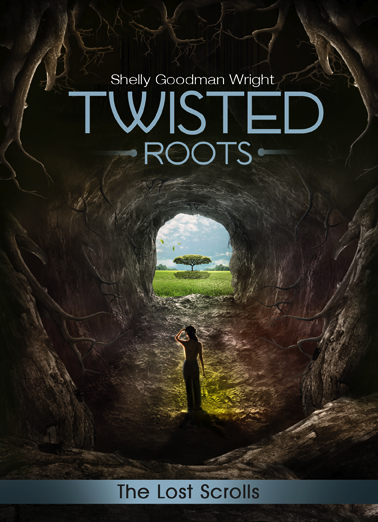
As the doorbell rang, I ran down the stairs to greet the postman. Five boxes filled with my newest novel sat on my porch. Of course my daughters rallied around me, excited for me to open the first box.
I'm so blessed by the support of my family, my church family, my FB family, and all my readers. If you loved the first book, 'A Light into the Darkness', I think you'll REALLY enjoy 'The Lost Scrolls'.
Three scrolls. Three continents. Three demons in pursuit.
The official release date is November 11, but you can pre-order it from Amazon and Barnes & Noble. OR you can buy it (PayPal--with the option to use a credit card) directly from me WITH FREE SHIPPING (a 4.99 value) and get it signed right off my website. If you don't have the first book, I'm offering a special deal for both books! A signed book makes a WONDERFUL gift for that reader in your family.
The T.V. trailer is finished, so be looking for it on Lifetime, Hallmark, ABC Family, and other networks (50,000 impressions/households should be seeing it). As soon as I get the final resolution trailer, I'll get the YouTube link up on my website.
**Update on book three--Legacy**
I've written most of Legacy, the final book in the TWISTED ROOTS Saga. I'll be working hard the next couple of month to finish it, edit it, and get it off to the publisher. I have another idea for series, but I'll wait to reveal that story line AFTER I do the final sign off on this series. :-)
Thank you again for your support!
Shelly
July 8, 2014
It's Summer!
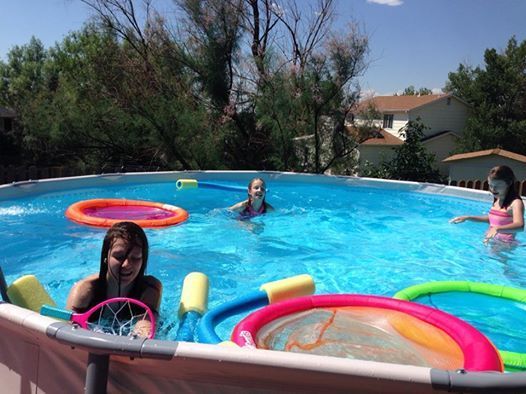
I spent the late part of spring (early summer) leveling a seventeen feet by sixteen feet piece of land, in-between my editing deadlines. See, I live on a sloped yard and have wanted a decent size pool forever. Wal-mart had this great deal on a 16'x48'' #Intex metal frame pool. Great price and big enough to actually swim in. After three weeks and several blisters, I finally got it up. The #pool isn't #perfectly #level but is only about an inch off.
Writing is a lot like that for me. When I start a new project, I'm determined to finish it even when I know the story might be slightly "off". Later, I'll go back to fine tune the problem areas and several drafts later I'll have a manuscript ready to pitch.
On another note, Twisted Roots--The lost scrolls, is in the final stages before heading to print! I'll be getting the paper back PROOF copy in the next week. I'll have thirty days to review it. Once I send it back and do one final sign off, I'll have an official release date. Very excited to have two books out there!
May 7, 2014
"To everything - turn, turn, turn..."
g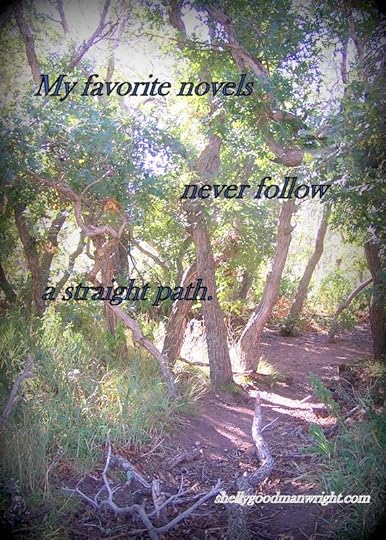
I'd say life isn't a straight path. We twist and turn, reach dead ends and closed doors, but the trick is to not give up. In general, we want our favorite characters to do the same. We want them to fulfil their task--their purpose and live happily ever after.
Life doesn't always mirror a 'happy ending', does it? Which is why getting lost in a good book can bring a certain feeling of contentment. We're so lost in 'their' world we get to forget the chaos in our own--even if it's only for a little while.
My parents fought a lot. The fights I remember the most were when I was ten years old. As the older of two sisters, I had my own room and would shut myself off. I can't remember how many times I read The Call ofthe Wild, or Lassie Come Home--the only books I had at that time--but they gave me comfort.
I want to say it was about a year later, when my parent's fights escalated, I began picking out longer novels. Little House on the Prairie, A Wrinkle inTime, Treasure Island, Moby Dick, and other classics, helped me get throughsome tougher times. However, it was when I started reading a series by V.C. Andrews, a desire started.
I wanted to be a novelist. I wanted to write stories for readers who needed the same escape I did. To create worlds and characters readers cared so deeply about, they thought about them long after they read the last page.
Now that I am an author, I hope I've done that!
Writers: What inspired you to want to write?
Readers: What were your favorite books to get lost in?



